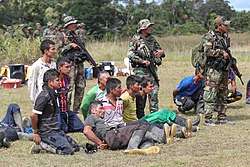FARC dissidents
FARC dissidents refers to a group, formerly part of the Revolutionary Armed Forces of Colombia, who have refused to lay down their arms after the FARC-government peace treaty came into effect in 2016 or resumed their insurgency afterwards.[1] As of 2018, the dissidents number some 2,000[4][5] to 2,500[2] armed combatants with an unknown number of civilian militia supporting them. The FARC dissidents have become "an increasing headache" for the Colombian armed forces, as they have to fight them, the EPL, ELN and Clan del Golfo at the same time.[4]
| FARC dissidents | |
|---|---|
| Participant in the Colombian conflict | |
 FARC coat of arms: shield, flag, and country At least some dissident groups use the regular flag of Colombia instead[1] | |
| Active | 2016–present |
| Ideology | |
| Political position | Far-left |
| Leaders | Gentil Duarte (alleged)[2] "The Poet"[1] Rogelio Guerrero[1] Ivan Marquez |
| Allies | |
| Opponent(s) | |
The FARC dissidents have been responsible for several attacks on the Colombian armed forces.[6][7][8] These fighters are believed to be heavily involved in the production and sale of cocaine.[9] In June 2020, it was revealed that the presence of FARC dissidents in northern Antioquia instigated a direct armed conflict with the Clan del Golfo known as Operation Mil.[3]
Organization
Leadership and membership
FARC dissidents are led by former mid-level commanders such as alias Gentil Duarte, alias Euclides Mora, alias Jhon 40, alias Giovanny Chuspas and alias Julián Chollo. The group has attempted to recruit locals in the Putumayo Province in Colombia to take up their cause.[10]
Locations
Dissidents of FARC's 1st Front are located in the eastern plains of Colombia. Jhon 40 and their dissident 43rd Front moved into the Amazonas state of western Venezuela where they can operate with Colombian allies. Venezuela has served as the primary location for many FARC dissidents.[2] Other dissidents hide in the mountains north of Medellín.[1]
Aims and ideology
Despite claiming to still follow the Leftist ideology of FARC, many dissidents are more motivated in their continuing struggle against the government by their inability to reintegrate into civilian society, a desire to protect themselves from other paramilitary or crime groups, and criminal connections. Dissident groups would become part of the rivalries between the different drug cartels, allying with some and fighting against others.[1]
Events

On 15 July 2018, the Colombian and Peruvian governments launched a joint military effort known as Operation Armageddon to combat FARC dissidents. Peru issued a 60-day state of emergency in the Putumayo Province, an area bordering both Colombia and Ecuador. On the first day alone, more than 50 individuals were arrested in the operation, with the majority being Colombian nationals, while four cocaine labs were dismantled.[10]
On June 26, Clan del Golfo and FARC dissidents were confirmed be in a direct armed conflict in northern Antioquia known as Operation Mil.[3] The Clan del Golfo, which dispatched 1,000 of its paramilitaries from Urabá, southern Córdoba and Chocó, hopes to remove FARC dissent from northern Antioquia and take control of the entire municipality of Ituango.[3]
References
- Nicholas Casey; Federico Rios Escobar (18 September 2018). "Colombia Struck a Peace Deal With Guerrillas — but Many Return to Arms". The New York Times. Retrieved 18 September 2018.
- Venezuela: A Mafia State?. Medellin, Colombia: InSight Crime. 2018. pp. 3–84.
- https://caracol.com.co/emisora/2020/06/27/medellin/1593219073_729114.html
- Cali, Casa Editorial El País. "Disidencias de las Farc, un 'blanco' cada vez más grande para las Fuerzas Armadas".
- "Disidencias de las Farc contarían con 1.200 hombres - ELESPECTADOR.COM". 20 March 2018.
- "Un ataque perpetrado por disidentes de las FARC dejó a 6 policías heridos en Colombia".
- "Policía murió en ataque atribuido a disidencia de FARC en Meta - Noticias Caracol". 25 February 2018.
- "Dos policías muertos en ataque donde opera disidencia de las FARC".
- "La historia de "Gentil Duarte", el disidente de las Farc más buscado del país - ELESPECTADOR.COM". 2 April 2018.
- "Peru arrests more than 50 in anti-drug bust at Colombian border". Reuters. 16 July 2018. Retrieved 18 July 2018.